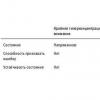Lazolvan solution for inhalation: instructions for use. Lazolvan solution for inhalation, rules for using Lazolvan types
The drug Lazolvan belongs to the group of potent mucolytics. The remedy has a pronounced expectorant effect, which makes it possible to use it for respiratory pathologies occurring in the acute or chronic stage.
For the treatment of defects respiratory tract often doctors advise Lazolvan for inhalation. Dispensing the medication with a nebulizer helps to improve the patient's condition and speed up the healing process.
The main active ingredient of the medication in question is Ambroxol. In addition, the tool contains the following auxiliary components:
- sodium chloride;
- monohydrate;
- distilled water;
- hydrogen phosphate.
The main active substance enhances the production of secretions in the respiratory system. Due to this, the process of excretion of sputum is accelerated, and the cough is converted into a productive one.
Long-term studies of the medication in question allowed scientists to prove that the course treatment with Lazolvan helps to reduce relapses in people with COPD.
Release form
Currently, the mucolytic drug Lazolvan is released in 4 forms:
- Lazolvan solution for oral administration and inhalation. The solution is dispensed in ampoules and nibules;
- oral tablets;
- syrup in a bottle. This form is more often prescribed for children and people who find it difficult to take pills. For the convenience of patients, a measuring cap is provided;
- lozenges for sucking.
Only a doctor can choose the type of drug in question suitable for use. Therefore, do not self-medicate. Moreover, the remedy has a number of contraindications and can provoke side effects.
Indications for use
Inhalations with Lazolvan are prescribed to eliminate respiratory diseases in which there is a violation of sputum discharge. Most often, a similar condition occurs with the following ailments:
- acute and chronic bronchitis;
- pneumonia;
- COPD;
- asthma, accompanied by difficulty in sputum discharge;
- bronchiectasis pathology.
In addition, the drug in question is often prescribed for angina, laryngitis, tracheitis, dry cough and pharyngitis. But it is important to consider that Lazolvan fights the consequences and does not have a detrimental effect on the root cause.

Mode of application
Lazolvan instructions for use are indicated for performing treatment sessions, it is required to prepare a solution. For these purposes, the agent is mixed with saline or borjomi in a 1: 1 ratio.
Composition
1 tablet contains: active ingredient: ambroxol hydrochloride 30 mg; excipients: dried corn starch, colloidal anhydrous silicon dioxide, lactose monohydrate, magnesium stearate.
Description
White or slightly yellowish, round, flat on both sides tablets with beveled edges, with a dividing line on one side and engraving 67C on both sides of the dividing line, on the other side of the tablet - the company logo.
Pharmacotherapeutic group
Cough and cold remedies. Mucolytic agents. ATX code: R05CB06.
Pharmacodynamics
Preclinical tests have shown that ambroxol hydrochloride, the active ingredient in LAZOLVAN, stimulates the secretion of the serous component of bronchial secretions. It also increases the secretion of surfactants as a result of direct action on type II pneumocytes located in the alveoli and Clara cells in the bronchioles, and also stimulates the activity of the ciliated epithelium. The described effects cause a decrease in sputum viscosity and an improvement in mucociliary clearance. Improvement in mucociliary clearance has been demonstrated in clinical pharmacological studies.
An increase in the secretion of the serous component of sputum and an increase in mucociliary clearance promote sputum discharge and relieve coughing.
In patients with COPD who took LAZOLVAN capsules of prolonged action 75 mg for 6 months, by the end of the 2nd month of treatment, a significant decrease in exacerbations was recorded compared with placebo. Patients in the LAZOLVANA group showed a significant decrease in the number of days of illness and a decrease in the number of days of administration. antibacterial drugs... Also, in the LAZOLVANE group, compared with placebo, there was a statistically significant improvement in the assessed symptoms, such as difficulty in passing sputum, cough, shortness of breath and auscultatory symptoms.
The local analgesic effect of ambroxol hydrochloride was observed in studies carried out on a rabbit eye model and is probably associated with blocking of sodium channels by the drug. In vitro tests have shown that the drug reversibly and dose-dependently blocks neuronal sodium channels.
In vitro, ambroxol hydrochloride was found to have anti-inflammatory effects. In in vitro tests, it significantly reduced
release of cytokines from circulating and tissue mononuclear and polymorphonuclear cells.
Clinical studies in patients with sore throat have shown that ambroxol hydrochloride 20 mg lozenge significantly reduces pain and redness in the throat.
These pharmacological properties confirm additional observation obtained in clinical research efficacy that inhalation of Ambroxol provides rapid pain relief when used in the treatment of upper respiratory tract diseases.
The use of ambroxol hydrochloride increases the concentration in sputum and bronchial secretions of antibiotics such as amoxicillin, cefuroxime, erythromycin and doxycycline. Today, clinical relevance
this effect has not been proven.
Pharmacokinetics
Suction
Absorption of ambroxol hydrochloride from the immediate-release oral forms is rapid and fairly complete, with a linear relationship over the therapeutic range. The maximum concentration in blood plasma is reached within 1-2.5 hours after ingestion dosage form with immediate release and, on average, 6.5 hours after taking the extended-release dosage form.
The absolute bioavailability after taking 30 mg tablets was 79%.
Distribution
The distribution of ambroxol hydrochloride from the blood to the tissue is rapid and pronounced, with the most high concentration active substance found in the lungs. The volume of distribution after oral administration is
In the therapeutic range, the plasma protein binding is about 90%. Metabolism and excretion
About 30% of the dose taken orally is excreted as a result of presystemic metabolism.
Ambroxol hydrochloride metabolism occurs predominantly in the liver by glucuronidation and partial degradation to dibromantranilic acid (approximately 10% of the dose). Studies of human liver microsomes have shown that CYP3A4 is responsible for the metabolism of ambroxol hydrochloride to dibromantranilic acid.
Within 3 days of oral administration, approximately 6% of the dose is found in free form, and about 26% of the dose appears in urine in the form of conjugates. The half-life of ambroxol hydrochloride from the body is 10 hours. The total clearance is in the range of 660 ml / min., Renal clearance provides approximately 8% of the total clearance. After 5 days, about 83% of the dose taken is excreted in the urine.
Pharmacokinetics in special groups patients
In patients with impaired liver function, the excretion of ambroxol hydrochloride decreases, which leads to an increase in its level in blood plasma by 1.3-2 times. V
due to the high therapeutic index of the drug, dose adjustment is not required.
The pharmacokinetics of ambroxol clinically reliably does not depend on age and gender, therefore, dosage changes are not required.
The bioavailability of ambroxol hydrochloride is independent of food intake.
Indications for use
Secretolytic therapy for acute and chronic bronchopulmonary diseases associated with impaired sputum formation and transport.
Method of administration and dosage
Children from 6 to 12 years old
Usually ½ tablet 2-3 times / day (corresponding to 2-3x15 mg of ambroxol hydrochloride per day).
Adults and children over 12 years old
Usually, 1 tablet 3 times / day (which corresponds to 3 x 30 mg of ambroxol hydrochloride per day) in the first 2-3 days, then 1 tablet 2 times / day (which corresponds to 2 x 30 mg of ambroxol hydrochloride per day).
For adults and children over 12 years of age, the therapeutic effect can be enhanced by increasing the dose to 2 tablets twice a day (which corresponds to 120 mg of ambroxol hydrochloride per day).
In case of impaired renal function or severely impaired liver function, LAZOLVAN should be taken only after consulting a doctor.
In patients with impaired liver function, the excretion of ambroxol hydrochloride decreases, which leads to an increase in its level in blood plasma by 1.3-2 times. Due to the high therapeutic index of the drug, no dose adjustment is required.
The pharmacokinetics of ambroxol clinically reliably does not depend on age and gender, therefore, dosage changes in elderly patients are not required.
LAZOLVAN 30 mg tablets should not be taken for more than 4-5 days without consulting a doctor.
If the next dose is missed, you should take it as soon as you remember. If it is almost time for your next dose, do not take the missed dose and continue as usual. Do not take a double dose to make up for a forgotten individual dose.
Mode of application
LAZOLVAN 30 mg tablets can be taken with or without food; the tablets should be swallowed whole and washed down with a sufficient amount of liquid (for example, water or fruit juice).
Side effect"type =" checkbox ">
Side effect
Criteria for assessing the incidence of adverse reactions medicinal product: very often (≥1 / 10); often (≥1 / 100,
Violations from the outside immune system
Rare: hypersensitivity reactions.
Frequency unknown: anaphylactic reactions, including anaphylactic shock, angioedema, itching.
Gastrointestinal disorders
Often: nausea.
Uncommon: vomiting, diarrhea, dyspepsia, abdominal pain.
Very rare: drooling.
Respiratory system, organ disorders chest and mediastinum
Frequency not known: shortness of breath (as a symptom of an allergic reaction).
Skin and subcutaneous tissue disorders
Rare: rash, urticaria.
Frequency unknown: severe skin reactions (including erythema multiforme, Stevens-Johnson syndrome, toxic epidermal necrolysis, acute generalized exanthematous pustulosis).
General disorders and reaction at the injection site
Uncommon: fever, mucosal reactions.
It is important to report suspected adverse reactions after registration medicinal product in order to ensure continuous monitoring of the benefit-risk ratio of the medicinal product. Healthcare providers are encouraged to report any suspected adverse drug reactions through the national ADR and drug ineffectiveness reporting systems. The patient, if he has any adverse reactions, it is recommended to consult a doctor. This recommendation applies to any possible adverse reactions, including those not listed in the instructions for use of the drug. You can also report adverse reactions to the Adverse Reactions (ADRs) Information Database, including reports of drug ineffectiveness. By reporting adverse reactions, you can help provide more information on the safety of this medicine.
Contraindications The drug LAZOLVAN 30 mg tablets is contraindicated in patients with known hypersensitivity to ambroxol hydrochloride or to any of the excipients. LAZOLVAN 30 mg tablets should not be administered to children under 6 years of age. Children under 6 years of age may be prescribed LAZOLVAN syrup and / or LAZOLVAN solution for inhalation.
Overdose Overdose symptoms in humans have not been described. In case of accidental overdose or cases of medical error, it has been reported that the observed symptoms correspond to the known side effects when taken in the recommended doses and may require symptomatic therapy.
Precautionary measures
There have been reports of the development of severe skin reactions such as erythema multiforme, Stevens-Johnson syndrome, toxic epidermal necrolysis, acute generalized exanthematous pustulosis in patients taking ambroxol.
If symptoms or signs of a progressive skin rash (sometimes associated with the development of blisters and lesions of the mucous membranes) are observed, it is necessary to immediately stop treatment with Abroxol and consult a doctor.
In patients with impaired bronchial motility and abundant sputum secretion (as, for example, in the rare syndrome of primary ciliary dyskinesia) LAZOLVAN 30 mg tablets should be used with caution due to the risk of sputum accumulation.
In case of impaired renal function or severely impaired liver function, LAZOLVAN should be taken only after consulting a doctor. Due to the fact that the drug is metabolized in the liver and excreted by the kidneys, in the case of severe renal dysfunction, the accumulation of ambroxol metabolites formed in the liver may occur.
One tablet contains 171 mg of lactose, which is 684 mg of lactose at the maximum recommended daily dose. LAZOLVAN 30 mg tablets should not be taken by patients with rare hereditary galactose intolerance, lactase deficiency, or poor absorption of glucose-galactose.
Pregnancy and lactation Ambroxol hydrochloride crosses the placental barrier. Animal studies have not shown any direct or indirect negative effects on pregnancy, embryonic / fetal development, childbirth or postnatal development. Extensive clinical experience the use of the drug later than the 28th week of pregnancy did not reveal any evidence of a negative effect on the fetus. However, it is recommended that you follow the usual precautions regarding the use of any drug during pregnancy. In particular, the use of LAZOLVAN is not recommended during the first trimester of pregnancy.
Period breastfeeding
Ambroxol, as shown in animal studies, is excreted from the body with breast milk... Use during breastfeeding is not recommended.
Fertility
Animal studies have not shown any direct or indirect negative effects on fertility.
Influence on the ability to drive and operate machinery There are no known cases of the effect of the drug on the ability to drive a car and work with mechanisms. No relevant studies have been carried out.
Interaction with other drugs The simultaneous use of LAZOLVAN 30 mg tablets and drugs that suppress coughs can lead to dangerous accumulation of sputum in the respiratory tract due to a weakening of the cough reflex. This combination should only be prescribed after a careful assessment of the risks and benefits.
Package There are 10 tablets in a blister. 2 or 5 blisters in a cardboard box with instructions for use.
In this article, you can read the instructions for using the medicinal product. Lazolvan... The reviews of site visitors - consumers of this medicine, as well as opinions of doctors of specialists on the use of Lazolvan in their practice are presented. A big request to more actively add your reviews about the drug: did the medicine help or did not help get rid of the disease, what complications and side effects were observed that may not have been declared by the manufacturer in the annotation. Lazolvan's analogs in the presence of available structural analogs. Use for the treatment of bronchitis, pneumonia and cough in adults, children, as well as during pregnancy and lactation.
Lazolvan- mucolytic drug.
Studies have shown that ambroxol (the active substance of the drug Lazolvan) increases secretion in the respiratory tract. Enhances the production of pulmonary surfactant and stimulates ciliary activity. These effects lead to increased mucus flow and transport (mucociliary clearance). Enhancing mucociliary clearance improves sputum flow and relieves coughing.
Pharmacokinetics
Lazolvan is characterized by rapid and almost complete absorption with a linear dose dependence in the therapeutic concentration range. The transition of ambroxol from blood to tissue when oral administration happens quickly. Highest concentrations active ingredient the drug is observed in the lungs. Approximately 30% of the dose taken undergoes a "first pass" effect through the liver. The remainder of Ambroxol is metabolized in the liver, mainly by conjugation.
Indications
Sharp and chronic diseases respiratory tract, accompanied by the release of viscous sputum:
- acute and chronic bronchitis;
- pneumonia;
- chronic obstructive pulmonary disease;
- bronchial asthma with difficulty in sputum discharge;
- bronchiectasis.
Forms of issue
Tablets 30 mg.
Syrup (children's form of the drug).
Solution for oral administration and inhalation.
Lozenges 15 mg.
Instructions for use and dosage
The drug in the form of tablets is prescribed for adults at 30 mg 3 times a day.
If necessary to strengthen therapeutic effect can be prescribed 60 mg 2 times a day. The tablets are taken after meals with some liquid.
The drug in the form of a syrup 15 mg / 5 ml is prescribed for adults and children over 12 years of age, 10 ml (2 teaspoons) 3 times a day; children aged 6 to 12 years - 5 ml (1 teaspoon) 2-3 times a day; children aged 2 to 6 years are prescribed 2.5 ml (1/2 teaspoon) 3 times a day; children under 2 years old - 2.5 ml (1/2 teaspoon) 2 times a day.
The drug in the form of a syrup 30 mg / 5 ml for adults and children over 12 years old is prescribed 5 ml (1 teaspoon) 3 times a day; children aged 6 to 12 years - 2.5 ml (1/2 teaspoon) 2-3 times a day.
Taking the drug for more than 4-5 days is possible only under the supervision of a doctor.
Lazolvan syrup should be taken with meals with some liquid.
Lazolvan in the form of a solution for inhalation can be used with the use of any modern inhalation device, except for vaporizing inhalers. The drug is mixed with saline in a 1: 1 ratio to achieve optimal air humidification in the respirator.
During inhalation, in order to avoid the cough reflex caused by a deep breath, the patient must breathe calmly. It is recommended to warm the inhaled solution to body temperature. Patients with bronchial asthma it is recommended to do inhalation after taking bronchodilators.
Side effect
- heartburn;
- dyspepsia;
- nausea, vomiting;
- diarrhea;
- skin rash;
- hives;
- angioedema;
- anaphylactic reactions (including anaphylactic shock).
Contraindications
- 1 trimester of pregnancy;
- hypersensitivity to the components of the drug.
Application during pregnancy and lactation
Lazolvan crosses the placental barrier.
In experimental studies on animals, no direct or indirect adverse effects on pregnancy, embryonic, prenatal and postnatal development and childbirth have been revealed.
Clinical studies at 28 weeks gestation found no evidence negative influence the drug on the fetus.
However, the usual precautions must be followed when using the drug during pregnancy. It is especially not recommended to take Lazolvan in the 1st trimester of pregnancy.
Ambroxol can be excreted in human milk. Therefore, it is not recommended to prescribe Lasolvan to nursing mothers. However, adverse effects in newborns are unlikely.
special instructions
It should not be used in combination with antitussives that impede the excretion of sputum.
Lazolvan syrup (15 mg / 5 ml) contains 10.5 g of sorbitol in terms of the maximum recommended daily dose (30 ml). Patients with rare hereditary fructose intolerance should not take this drug. It can also have a mild laxative effect.
Lazolvan syrup (30 mg / 5 ml) contains 5 g of sorbitol in terms of the maximum recommended daily dose (20 ml). Patients with rare hereditary fructose intolerance should not take this drug.
Lazolvan tablets (30 mg) contain 684 mg of lactose in terms of the maximum recommended daily dose (120 mg). Patients with rare hereditary galactose intolerance, Lapp lactase deficiency or impaired glucose / galactose absorption should not take this drug.
Very rare cases of severe skin lesions have been reported, such as Stevens-Johnson syndrome and Lyell's syndrome; however, a link to the drug has not been proven. With the development of the above syndromes, it is recommended to stop treatment and immediately seek medical help.
Drug interactions
Simultaneous use with antitussive drugs leads to difficulty in sputum discharge against the background of a decrease in cough.
Ambroxol increases the penetration into the bronchial secretions of amoxicillin, cefuroxime, erythromycin, doxycycline.
Lazolvan is compatible with drugs that inhibit labor.
Analogs of the drug Lazolvan
Structural analogues for the active substance:
- Ambrobene;
- AmbroGEXAL;
- Ambroxol;
- Ambroxol Vramed;
- Ambroxol retard;
- Ambroxol-Werte;
- Ambroxol-Vial;
- Ambroxol-Richter;
- Ambroxol-Teva;
- Ambroxol-Hemofarm;
- Ambrolan;
- Ambrosan;
- Ambrosol;
- Bronchoxol;
- Bronchorus;
- Dephlegmin;
- Bronhovern drops;
- Lazolangin;
- Medox;
- Mucobron;
- Neo-Bronchol;
- Remebrox;
- Suprima-kof;
- Fervex for cough;
- Flavamed;
- Haliksol.
In the absence of analogues of the drug for the active substance, you can follow the links below to the diseases for which the corresponding drug helps, and see the available analogues for the therapeutic effect.
Composition
1 ml of solution contains:
Active substance: ambroxol hydrochloride 7.5 mg.
Excipients: citric acid monohydrate (E330), disodium hydrogen phosphate dihydrate (E339), sodium chloride, benzalkonium chloride, purified water.
Description
Transparent, colorless or slightly brownish solution.
Pharmacotherapeutic group
Expectorants, excluding combinations with antitussives. Mucolytic agents. ATX code: R05CB06.
pharmachologic effect
Pharmacodynamics
Preclinical tests have shown that ambroxol hydrochloride, the active ingredient in LAZOLVAN, stimulates the secretion of the serous component of bronchial secretions. It also increases the secretion of surfactants as a result of direct action on type II pneumocytes located in the alveoli and Clara cells in the bronchioles, and also stimulates the activity of the ciliated epithelium. The described effects cause a decrease in sputum viscosity and an improvement in mucociliary clearance. Improved mucociliary clearance has been demonstrated in clinical pharmacological studies. An increase in the secretion of the serous component of sputum and an increase in mucociliary clearance promote sputum discharge and relieve coughing.
In patients with COPD who took LAZOLVAN capsules of prolonged action 75 mg for 6 months, by the end of the 2nd month of treatment, a significant decrease in exacerbations was recorded compared with placebo. Patients in the LAZOLVANA group showed a significant decrease in the number of days of illness and a decrease in the number of days of taking antibacterial drugs. Also, in the LAZOLVANE group, compared with placebo, there was a statistically significant improvement in the assessed symptoms, such as difficulty in passing sputum, cough, dyspnea and auscultatory symptoms.
The local analgesic effect of ambroxol hydrochloride was observed in studies carried out on a rabbit eye model and is probably associated with blocking of sodium channels by the drug. In vitro tests have shown that the drug reversibly and dose-dependently blocks neuronal sodium channels.
In vitro, ambroxol hydrochloride was found to have anti-inflammatory effects. In in vitro tests, it significantly reduced the release of cytokines from circulating and tissue mononuclear and polymorphonuclear cells.
Clinical studies in patients with sore throat have shown that ambroxol hydrochloride 20 mg lozenge significantly reduces pain and redness in the throat.
These pharmacological properties support the additional observation from clinical efficacy studies that inhalation of Ambroxol provides rapid pain relief when used in the treatment of upper respiratory tract diseases.
The use of ambroxol hydrochloride increases the concentration in sputum and bronchial secretions of antibiotics such as amoxicillin, cefuroxime, erythromycin and doxycycline. To date, the clinical significance of this effect has not been proven.
Pharmacokinetics
Suction
Absorption of all oral forms of immediate release ambroxol hydrochloride is rapid and fairly complete, with a linear relationship over the therapeutic range. The maximum concentration in blood plasma is reached within 1-2.5 hours after ingestion of the immediate-release dosage form and, on average, 6.5 hours after taking the prolonged-release dosage form.
The absolute bioavailability after taking 30 mg tablets was 79%. The relative bioavailability of the sustained-release capsules was 95% (normalized dose) compared to daily dose 60 mg (30 mg twice daily) immediate-release tablets.
Distribution
The distribution of ambroxol hydrochloride from the blood into the tissues is fast and efficient, with the highest concentration of the active substance found in the lungs. The volume of distribution after oral administration is 552 liters.
In the therapeutic range, the plasma protein binding is about 90%.
Metabolism and excretion
About 30% of the dose taken orally is excreted as a result of presystemic metabolism.
Ambroxol hydrochloride metabolism occurs predominantly in the liver by glucuronidation and partial degradation to dibromantranilic acid (approximately 10% of the dose). Studies of human liver microsomes have shown that CYP3A4 is responsible for the metabolism of ambroxol hydrochloride to dibromantranilic acid.
Within 3 days of oral administration, approximately 6% of the dose is found in free form, and about 26% of the dose appears in the urine in the form of conjugates.
The half-life of ambroxol hydrochloride from the body is 10 hours. The total clearance is in the range of 660 ml / min., Renal clearance provides approximately 83% of the total clearance.
Pharmacokinetics in special patient groups
In patients with impaired liver function, the excretion of ambroxol hydrochloride decreases, which leads to an increase in its level in blood plasma by 1.3-2 times.
The pharmacokinetics of ambroxol clinically reliably does not depend on age and gender, therefore, dosage changes are not required.
The bioavailability of ambroxol hydrochloride is independent of food intake.
Indications for use
Secretolytic therapy for acute and chronic bronchopulmonary diseases associated with impaired sputum formation and transport.
Method of administration and dosage
Adults and children over 6 years old: 2-3 ml of solution 1-2 times a day (which corresponds to 15-22.5 mg of ambroxol hydrochloride 1-2 times a day).
LAZOLVAN solution for inhalation should not be taken for more than 4-5 days without consulting a doctor.
Mode of application
LAZOLVAN solution for inhalation can be used in various modern inhalation devices (for example, compressor and ultrasonic ones), with the exception of steam inhalers. Heating the solution to 80 ° C for 10 minutes does not adversely affect stability.
LAZOLVAN solution for inhalation can be mixed with physiological saline and beta-sympathomimetics.
LAZOLVAN solution for inhalation should not be mixed with cromoglycic acid. In addition, it is not recommended to mix the drug with other solutions if the result is a mixture with a pH higher than 6.3, for example, with an alkaline sea water for inhalation. Increased value pH can lead to precipitation of the free base of ambroxol hydrochloride or cloudiness of the solution.
To obtain optimal humidification of breathing air when used in a LAZOLVAN respirator, the inhalation solution is mixed with a physiological saline solution in a 1: 1 ratio.
The inhalation solution is isotonic and therefore does not adversely affect the mucous membranes. However, inhalation itself can provoke a cough, so it is recommended to breathe normally during inhalation.
Before inhalation, the solution should be warmed up to body temperature.
Side effect
Criteria for assessing the incidence of adverse drug reactions: very often (≥1 / 10), often (from ≥1 / 100 to<1/10), нечасто (от ≥ 1/1000 до <1/100), редко (от ≥1/10000 до <1/1000), очень редко (<1/10000), неизвестно (частота не может быть оценена по имеющимся данным).
From the immune system
Rare: hypersensitivity reactions.
Unknown: anaphylactic reactions, including anaphylactic shock, angioedema, itching.
From the side nervous system
Often: dysgeusia (change in taste).
From the gastrointestinal tract
Often: nausea, feeling of numbness in the mouth.
Uncommon: vomiting, diarrhea, dyspepsia, abdominal pain, dry mouth.
Rarely: dryness in the throat.
Very rare: sialorrhea (excessive salivation).
From the respiratory system, chest and mediastinal organs
Often: feeling of numbness in the throat.
Very rare: shortness of breath and bronchospasm (usually in patients with known airway hypersensitivity).
Not known: shortness of breath (as a symptom of a hypersensitivity reaction).
On the part of the skin and subcutaneous tissues
Rare: rash, urticaria.
Not known: severe skin reactions (including erythema multiforme, Stevens-Johnson syndrome, toxic epidermal necrolysis, acute generalized exanthematous pustulosis).
General disorders and reaction at the injection site
Uncommon: fever, mucosal reactions.
Reporting adverse reactions
It is important to report suspected adverse reactions after registration of the medicinal product in order to ensure continuous monitoring of the benefit-risk ratio of the medicinal product. Healthcare providers are encouraged to report any suspected adverse drug reactions through the national ADR and drug ineffectiveness reporting systems. The patient, if he has any adverse reactions, it is recommended to consult a doctor. This recommendation applies to any possible adverse reactions, including those not listed in the instructions for use of the drug. You can also report adverse reactions to the Adverse Reactions (ADRs) Information Database, including reports of drug ineffectiveness. By reporting adverse reactions, you can help provide more information on the safety of this medicine.
Contraindications
Hypersensitivity to the active substance, ambroxol hydrochloride, or other components of the drug.
LAZOLVAN solution for inhalation should be used in children under 6 years of age only as directed by a doctor.
The dose for children under 6 years of age has not been established. Children under 6 years of age may be prescribed LAZOLVAN syrup and / or LAZOLVAN drops.
Overdose
Overdose symptoms in humans have not been described. In case of accidental overdose or cases of medical error, it was reported that the observed symptoms correspond to the known side effects when used in the recommended doses and may require symptomatic therapy.
Precautionary measures
When inhaled, there is a risk of bronchospastic reaction, therefore LAZOLVAN solution for inhalation should not be used in patients with known bronchial hyperreactivity and / or atopy.
There have been reports of the development of severe skin reactions such as erythema multiforme, Stevens-Johnson syndrome, toxic epidermal necrolysis, acute generalized exanthematous pustulosis in patients taking ambroxol.
It is necessary to immediately stop using the drug if symptoms of a progressive skin reaction appear (sometimes associated with the development of blisters and damage to the mucous membranes) and consult a doctor.
In patients with impaired bronchial motility and abundant sputum secretion (as, for example, in the rare syndrome of primary ciliary dyskinesia), LAZOLVAN should be used with caution due to the risk of sputum accumulation.
In case of impaired renal function or severe impairment of liver function, LAZOLVAN should be used only after consulting a doctor. Due to the fact that the drug is metabolized in the liver and excreted by the kidneys, in the case of severe renal dysfunction, the accumulation of ambroxol metabolites formed in the liver may occur.
LAZOLVAN contains the preservative benzalkonium chloride, which, if inhaled, can cause bronchospasm.
Pregnancy and the period of breastfeeding
Pregnancy
Ambroxol hydrochloride crosses the placental barrier. Animal studies have not shown any direct or indirect negative effects on pregnancy, embryonic / fetal development, childbirth or postnatal development. Extensive clinical experience with the drug after the 28th week of pregnancy did not reveal any evidence of a negative effect on the fetus. However, it is recommended that you follow the usual precautions regarding the use of any drug during pregnancy. In particular, the use of LAZOLVAN is not recommended during the first trimester of pregnancy.
Breastfeeding period
Ambroxol has been shown in animal studies to be excreted in breast milk. Use during breastfeeding is not recommended.
Fertility
Animal studies have not shown any direct or indirect negative effects on fertility.



















